Factors of Attraction Towards Women: A Replication
In What Do We Desire in a Woman?, Apple Pie conducted surveys on romantic preferences, asking participants to rate several traits based on how attractive they are. The following is a replication of the analysis using confirmatory factor analysis (CFA) and item response theory (IRT), rather than using principal components analysis (PCA) as Apple Pie did. PCA forces factors to be independent, while CFA allows factors to correlate. IRT also provides more item-level information.
Factor Analysis Results
I found 8 interpretable factors of male attraction towards women. I’ve labeled them by the archetypes that best exemplify them:
- Curvy Girl
- Free Spirit
- Intellectual
- Amazon
- Nice Girl
- Girl Next Door
- Fashionista
- Innocent Girl
For reference, here are the factors that Apple Pie found:
- Factor 0: The Overall Average
- Factor 1: Skinny Girls vs BBWs
- Factor 2: Vapid Chicks vs Great Personalities
- Factor 3: The Barbie Dimension
- Factor 4: The MILF Dimension
- Factor 5: Temptresses vs Trad Wives
Some similarities:
- Apple Pie’s “Skinny Girls vs BBWs” factor most closely matched my “Curvy Girls” factor.
- Apple Pie’s “Vapid Chicks vs Great Personalities” most closely matched my “Intellectual” factor.
- Apple Pie’s “Barbie” factor most closely matched my “Fashionista” factor.
- Apple Pie’s “MILF” factor most closely matched a mixture of my “Girl Next Door” factor and and a reversed version of my ‘Innocent Girl’ factor.
- Apple Pie’s “Temptresses vs Trad Wives” factor most closely matched a mixture of my “Innocent Girl” factor and my “Nice Girl” factor.
Factor 1: Curvy Girls
The following items loaded onto this factor:
- Fat thighs (0.85)
- Unusually Curvaceous (0.85)
- Big Bellies (0.85)
- Wide hips (0.82)
- Bulging booty (0.76)
- Very large breasts (0.76)
- Comfortably Overweight (0.75)
- Heavyset (0.67)
- Slender (-0.58)
- Narrow hips (-0.51)
- Tight little buns (-0.45)
- Fertile (0.36)
- Little Black Dresses (-0.32)
This factor is straightforward. The items mostly focus on bodily features of the overweight, and the items focusing on thinness (e.g., ‘Slender’, ‘Narrow hips’) have negative loadings. As we can see in the Tailcalled diagram, a large number of items of varying difficulties means we’re able to measure this factor pretty well.
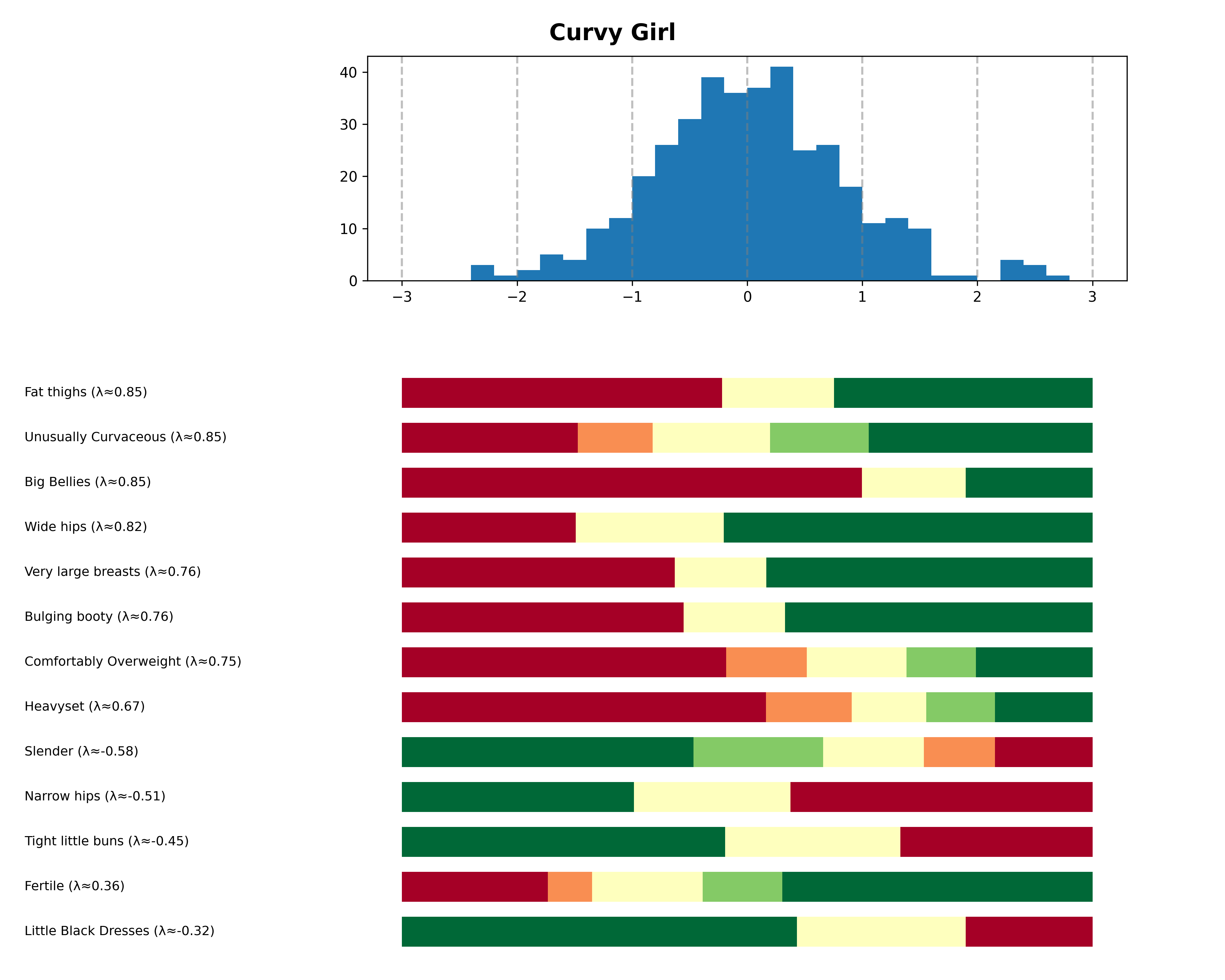
Factor 2: Free Spirits
The following items loaded onto this factor:
- Adventurous (0.72)
- Artistic (0.71)
- Enthusiastic (0.69)
- A Good Dancer (0.68)
- Musically Talented (0.61)
- Extremely Amorous (0.55)
- The Life of the Party (0.54)
- Dangerous (0.40)
- Unfaithful (0.28)
This factor is a bit more abstract. Looking at the items, I can’t help but be reminded of the Manic Pixie Dream Girl (MPDG) trope, with the items about adventurousness, artistic talents, and especially the item about being ‘Extremely Amorous’, all various facets of the trope.
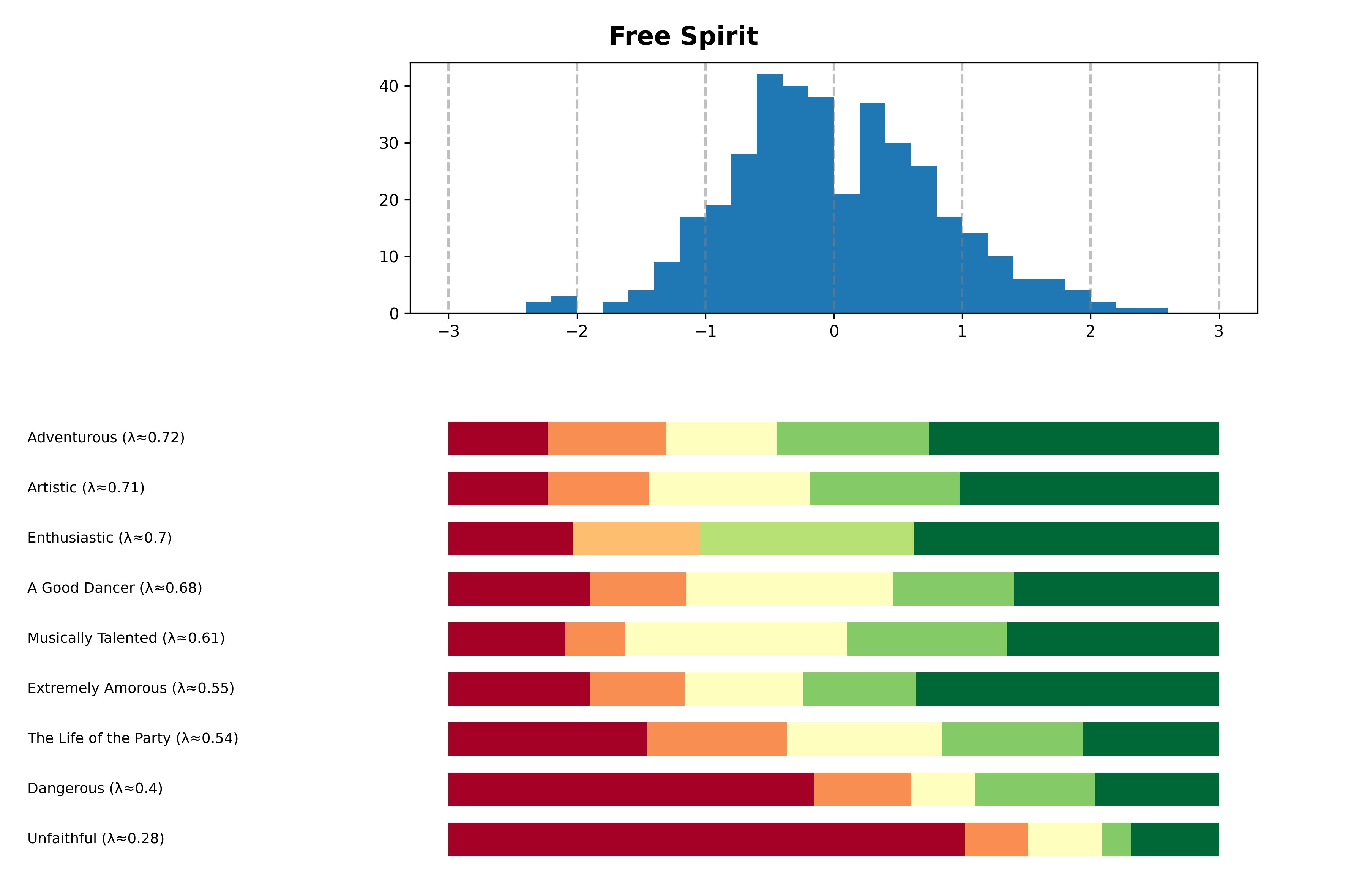
Factor 3: Intellectuals
The following items loaded onto this factor:
- Educated (0.85)
- Uneducated (-0.79)
- Not so bright (-0.75)
- Brilliant (0.72)
- Witty (0.65)
- Free Thinking (0.45)
- Mature (0.34)
- Simple Spoken (-0.27)
This is another straightforward factor. The positive-loading items are related to being smart, while the negative-loading items are related to being dumb. Despite the simplicity, we’re not able to measure the factor well at the upper end; most men think intelligence is attractive, so it’s difficult to determine who really loves intelligence.
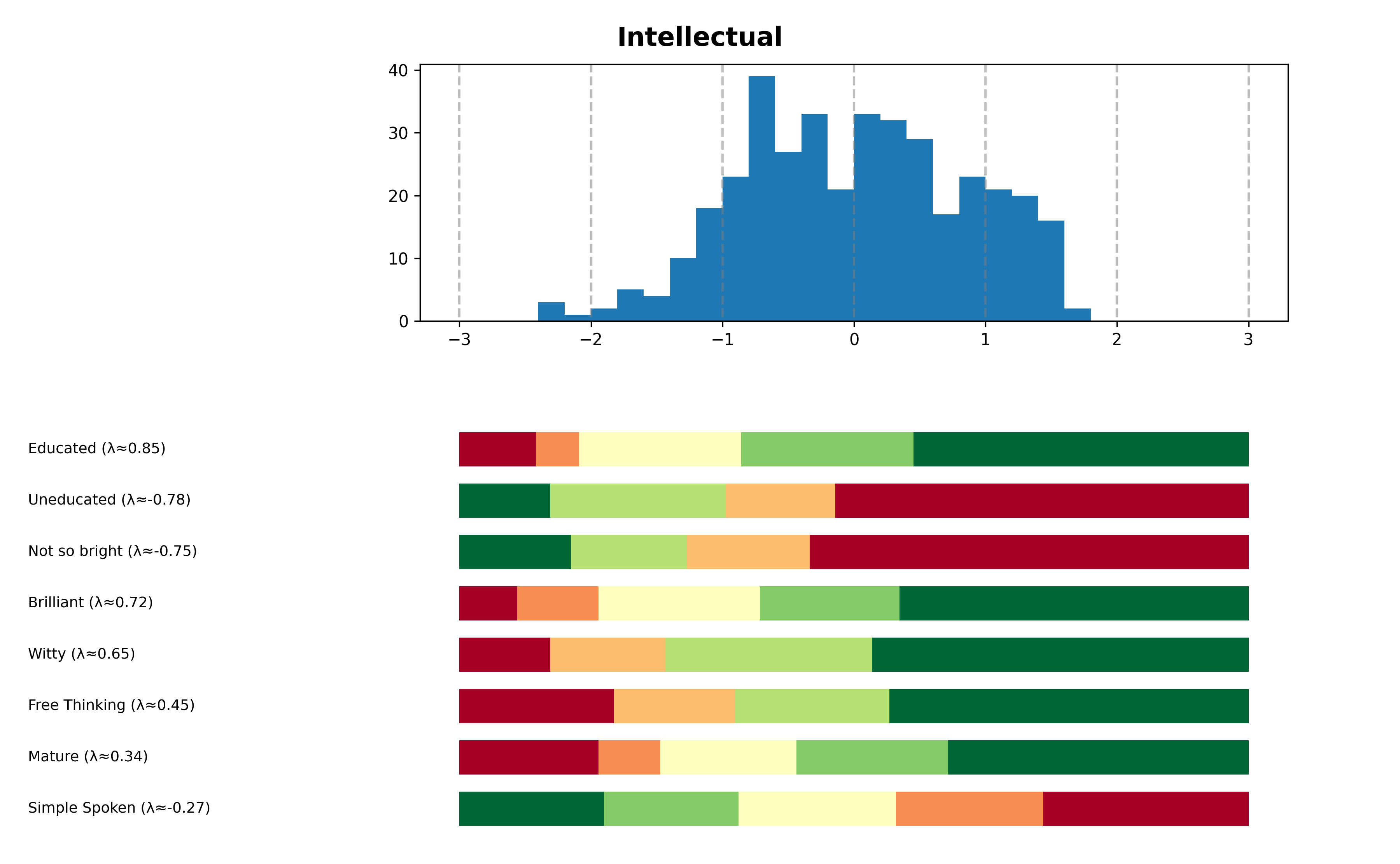
Factor 4: Amazons
The following items loaded onto this factor:
- Extremely Tall (0.67)
- Long legs (0.41)
- Broad shoulders (0.40)
- Short (-0.39)
- Heavyset (0.39)
- Athletic (0.27)
Yet another straightforward factor. I don’t have any commentary.
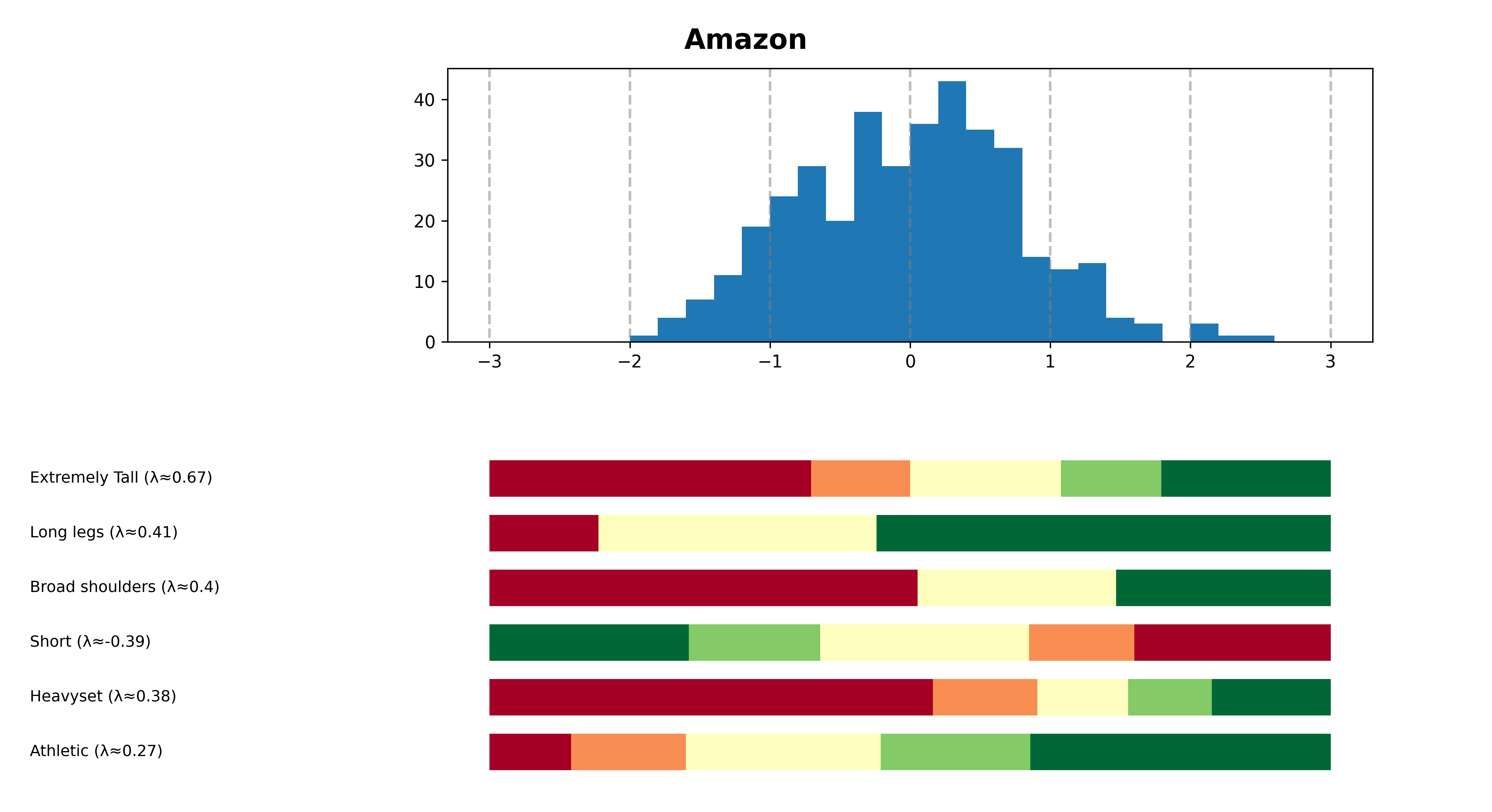
Factor 5: Nice Girls
The following items loaded onto this factor:
- Kind (0.65)
- Sympathetic (0.56)
- Humorous (0.29)
- Dangerous (-0.24)
There aren’t many items on this factor, and half of them have low loadings. Nevertheless, we can gather an idea of what the factor is measuring: niceness. Unfortunately, a low number of items + low loadings for some of them + low ceilings (most men find niceness attractive!) means we’re not able to measure this factor well, especially at the upper end.

Factor 6: Girl Next Door
The following items loaded onto this factor:
- Dark skin (0.51)
- T-Shirt & Jeans (0.51)
- Glasses (0.48)
- Tight little buns (0.44)
- Curly hair (0.40)
- Ponytails (0.40)
- Short hair (0.37)
- Older women (0.37)
- Dominant (0.36)
- Red Hair (0.34)
- Small Hands (0.33)
- Short (0.31)
- Broad shoulders (0.28)
This factor contains a lot of seemingly disparate items. As such, none of the items load especially high.
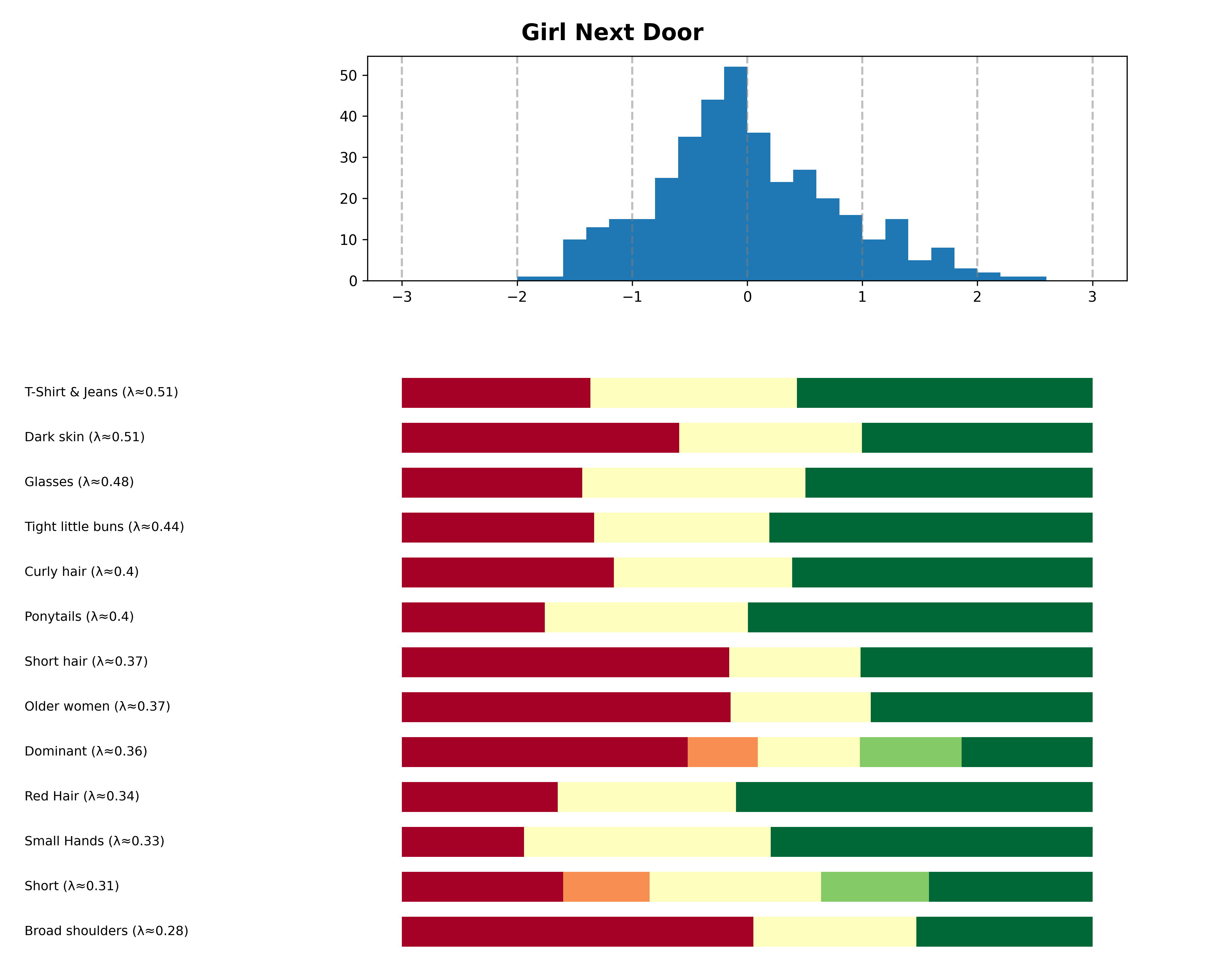
Factor 7: Fashionistas
The following items loaded onto this factor:
- High Heels (0.86)
- Nail Polish (0.75)
- Red lipstick (0.71)
- Little Black Dresses (0.60)
- Jewelry (0.49)
- Long legs (0.48)
- Tight Corsets (0.44)
- Shaved legs (0.42)
This factor deals with (fashionable?) clothes and accessories, along with sexy legs. Unfortunately for us, many men think these are attractive, so we have trouble measuring the high end of the spectrum.

Factor 8: Innocent Girls
The following items loaded onto this factor:
- Young (0.78)
- Submissive (0.71)
- Fertile (0.65)
- Cheerleaders (0.60)
- Small Hands (0.60)
- Slender (0.59)
- Teenagers (0.55)
- Fair skin (0.50)
- Good with Children (0.49)
- A Good Cook (0.43)
- Light eyes (0.42)
- Little noses (0.40)
- Dominant (-0.37)
- Older women (-0.36)
- Shy (0.35)
- Dark skin (-0.35)
- Short hair (-0.34)
- Broad shoulders (-0.30)
This factor contains items connected to youth (e.g., ‘Young’, ‘Fertile’, ‘Teenagers’) and (housewife-themed) submissiveness (e.g., ‘Submissive’, ‘Good with Children’, ‘A Good Cook’). There are also items relating to traditional beauty standards (e.g., ‘Slender’, ‘Fair skin’, ‘Broad shoulders’ [reversed]). Overall, the items measure the factor decently.

Internal consistency
Coefficient omega is a measure of a scale’s internal consistency. It represents the proportion of total variance in the responses that is explained by a single, underlying factor. If we calculate the coefficient omega for each factor, they end up clustering into three groups, giving us a sense of how coherent the factors are:
- The Curvy Girl ($\omega = 0.54$) and Innocent Girl ($\omega = 0.55$) factors both have mediocre internal consistencies, albeit, the highest of the factors we’ve extracted.
- The Free Spirit ($\omega = 0.29$), Intellectual ($\omega = 0.26$), Girl Next Door ($\omega = 0.28$), and Fashionista ($\omega = 0.26$) factors have low internal consistencies. These factors didn’t have as many items as the above two factors (an average of 9.5 vs 15.5). Additionally, they also have less items with particularly high loadings.
- The Amazon ($\omega = 0.09$) and Nice Girl ($\omega = 0.04$) factors have atrocious internal consistencies. In addition ing a low number of items (4 and 6 respectively), they have few items with high loadings (they both have only 1 item with a loading over 0.60).
While these results may be discouraging, it’s important to realize that the items weren’t designed as a scale, merely as part of an exploratory data analysis process. Using the information gained from analyses like these, future researchers will be able to design better scales.
Factor Correlation Matrix
| Curvy Girl | Free Spirit | Intellectual | Amazon | Nice Girl | Girl Next Door | Fashionista | Innocent Girl | |
|---|---|---|---|---|---|---|---|---|
| Curvy Girl | 1 | 0.19 | 0.05 | 0.06 | 0.07 | 0.17 | 0.12 | -0.22 |
| Free Spirit | 0.19 | 1 | 0.27 | 0.06 | 0.18 | 0.27 | 0.24 | 0.15 |
| Intellectual | 0.05 | 0.27 | 1 | 0.09 | 0.17 | 0.10 | -0.06 | -0.10 |
| Amazon | 0.06 | 0.06 | 0.09 | 1 | -0.05 | 0.18 | -0.01 | -0.18 |
| Nice Girl | 0.07 | 0.18 | 0.17 | -0.05 | 1 | 0.08 | 0.03 | 0.13 |
| Girl Next Door | 0.17 | 0.27 | 0.10 | 0.18 | 0.08 | 1 | 0.20 | -0.02 |
| Fashionista | 0.12 | 0.24 | -0.06 | -0.01 | 0.03 | 0.20 | 1 | 0.23 |
| Innocent Girl | -0.22 | 0.15 | -0.10 | -0.18 | 0.13 | -0.02 | 0.23 | 1 |
Notable positive correlations include the ones between Free Spirit & Intellectual, Free Spirit & Girl Next Door, and Free Spirit & Fashionista. I don’t know why these correlations appear.
Notable negative correlations include the ones between Curvy Girl & Innocent Girl, and Amazon & Innocent Girl. This also makes sense: both the Curvy Girl archetype and the Amazon archetype are “big”, and that’s reflected in the items that load on them. Meanwhile, the Innocent Girl factor has items that reflect smallness, such as ‘Slender’, ‘Small Hands’, and ‘Little noses’.
Takeaways
The scales can be improved substantially. While many factors need more items, others need items that specifically target the high end of the spectrum. One way to achieve this may be phrasing the traits as negative. For example, looking at the Intellectual factor, all the positive-loading items have positive connotations, while the negative-loading items have negative connotations. Adding items such as ‘Know it all’ and ‘Pedantic’, which are related to the factor, but generally viewed negatively, can help counter the ceiling effects we see. Additional potential changes include:
- For the Free Spirit factor, going off the MPDG trope, we can add items like ‘Quirky’, ‘Eccentric’, ‘Energetic’, etc.
- For the Amazon factor, we can add more of the obvious items, such as ‘Strong’, ‘Muscular’, ‘Big Biceps’, etc.
- For the Nice Girl factor, in addition to adding more items in general (e.g., ‘Friendly’), we can also add positive-loading negative-connotation items (e.g., ‘Bleeding-heart’).
- For the Girl Next Door factor, I’m not sure what items to add. We can try throwing things at the wall and seeing what sticks.
- For the Fashionista factor, we can add more of the obvious items, such as ‘Skirts’, ‘Makeup’, etc.
Another takeaway is that using more sophisticated methods yields deeper insights. Using confirmatory factor analysis, we were able to extract more factors from the data, and also see how those factors correlate. Using item response theory, we were able to see the flaws in the scales and how to improve them. More advanced methods lead to clearer, more informative results.
Thanks to Apple Pie for sharing the data!